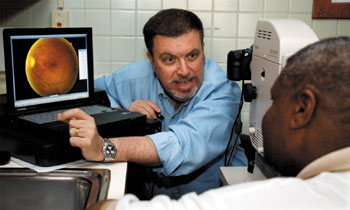
Larry Merin shows Meharry patient Thomas Harrison a photograph of his retina taken with the revised camera equipment. (photo by Dana Johnson)
Juvenile diabetes might be prevented
Someone is diagnosed with Type 1 diabetes every hour. This disease – also known as juvenile diabetes – strikes children suddenly, makes them insulin dependent for life, and carries the constant threat of devastating complications.
A novel discovery in the laboratory of Luc Van Kaer, Ph.D., associate professor of Microbiology and Immunology, may lead to a way to prevent the onset of this disease that currently affects more than one million Americans. An article published in the September issue of Nature Medicine describes how a unique chemical, alpha-galactosylceramide (alpha-GalCer), prevents development of Type 1 diabetes in mice by a mechanism predicted to have a parallel in humans.
Type 1 diabetes is a disease in which the body’s immune system goes awry, attacking and destroying the insulin-producing beta cells in the pancreas. Taking insulin allows a diabetic person to stay alive, but it does not cure the disease nor does it prevent its eventual and severe effects: kidney failure, blindness, nerve damage, amputations, heart attack, and stroke.
Van Kaer, an assistant investigator of the Howard Hughes Medical Institute, and his co-workers used mouse models to demonstrate that alpha-GalCer activates a unique type of immune cell – a natural killer T cell (NKT cell) – that in turn suppresses the pathogenic T cells that errantly attack pancreatic beta cells. If this same pattern were to occur in the human immune system, the chemical could be given to children known to have a genetic predisposition for diabetes – those who have siblings with the disease, for example – to prevent destruction of the pancreas and its debilitating consequences.
“When you have identified children having high risk of developing Type 1 diabetes,” Van Kaer said, “you could give them a course of treatment like this, perhaps for half a year or so, and then stop the treatment. If that intervention would lead to an individual not getting diabetes, that would certainly be quite an accomplishment.”
Originally isolated from marine sponges, alpha-GalCer was first investigated by Japanese scientists as a potential cancer treatment. They found that the chemical demonstrated profound anti-tumor properties in mice, characterized by a mechanism involving NKT cells.
Van Kaer, already studying the immune function of NKT cells in his lab, theorized that the chemical might be useful in modulating autoimmune diseases, such as Type 1 diabetes. He and his co-workers discovered by injecting alpha-GalCer into normal mice that a complex formed between it and a molecule called CD1. This complex activated NKT cells and had an overall suppressive effect on immunity. To characterize the recognition system and function of alpha-GalCer, Van Kaer’s lab generated a strain of mice that lacks the CD1 molecule and shows a dramatically reduced number of NKT cells.
The researchers also made use of a strain of non-obese diabetic (NOD) mice in which nearly all females develop Type 1 diabetes in their lifetime with a course similar to that seen in human disease. In this strain, about 90 percent of female mice develop diabetes by 35 weeks of age. Injection of alpha-GalCer into mice twice a week, beginning at age 5 weeks, prevented the development of diabetes in nearly all of the mice.
To test whether this effect was mediated by NKT cells, the NOD mice were bred with the CD1 knock-out mice, creating a strain that lacked CD1 and NKT cells but still developed diabetes. Injecting alpha-GalCer into these mice did not prevent the disease, Van Kaer said. These experiments indicated that the preventive effect is NKT cell-dependent. The data further showed that the chemical works by suppressing production of INF-gamma, a signaling protein responsible for sending the misguided message to the immune system to destroy the body’s own cells.
Evaluation of the safety and efficacy of using alpha-GalCer as a treatment for cancer in humans is currently underway, headed by a group in Japan. And, Van Kaer said, the same group is interested in starting safety trials for the treatment of Type 1 diabetes. A number of different investigators are testing the effect of this chemical on other autoimmune diseases. Van Kaer himself anticipates a forthcoming publication describing its effects in an experimental mouse model of multiple sclerosis.
In future experiments, Van Kaer’s lab will test the effect of analogs of alpha-GalCer in diabetes. Also, the researchers will evaluate how alpha-GalCer works in combination with other therapeutics, proven or in testing, to see if effectiveness is enhanced.
Researchers at Vanderbilt who participated in the work include: Seokmann Hong and Michael T. Wilson, graduate students who shared in first authorship of the paper; Nagendra Singh, Ph.D.; David Scherer, Ph.D.; Dr. Lan Wu; Dr. Alvin C. Powers; and Jie Wei. The research was funded by the Howard Hughes Medical Institute and a discovery grant from the Diabetes Research and Training Center at Vanderbilt.













